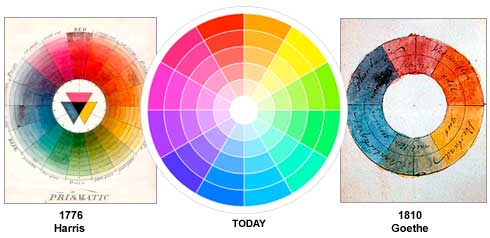Colour theories create a logical structure for colour, for example if we have an assortment of fruits and vegetables, we can organise them by colour and place them on a circle that shows the colours in relation to each other.
The Colour Wheel.
A colour circle based on red, yellow and blue is traditional in the field of art. Sir Isaac Newton developed the first circular diagram of colours in 1666. Since then, scientists and artists have studied and designed numerous variations of the concept. Differences of opinion about the validity of one format over another continue to provoke debate. In reality, any colour circle that presents a logical arranged sequence of pure hues has merit.

There are also definitions of colours based on the colour wheel. Primary, Secondary and Tertiary colours.
Primary: red, yellow and blue.
Secondary: green orange and purple.
Tertiary: yellow-orange, red-orange, red-purple, blue-purple, blue-green and yellow-green.

Colour Harmony.
Harmony can be defined as a pleasing arrangement of parts, whether it be music, poetry or colour.
In visual experiences, harmony is something that is pleasing to the eye. It engages the viewer and it creates an inner sense of order, a balance in the visual experience. When something is not harmonious, it's either boring or chaotic. At one extreme is a visual experience that is so bland that the viewer is not engaged. The human brain will reject under-stimulating information. At the other extreme is a visual experience that is so chaotic that the viewer can't stand to look at it. The human brain rejects whatever it cannot organise or understand. The visual task requires that we present a logical structure. Colour harmony delivers visual interest and a sense of order.
Colour Context.
The way colours behave in relation to other colours and shapes is a complex are of colour theory.
No comments:
Post a Comment